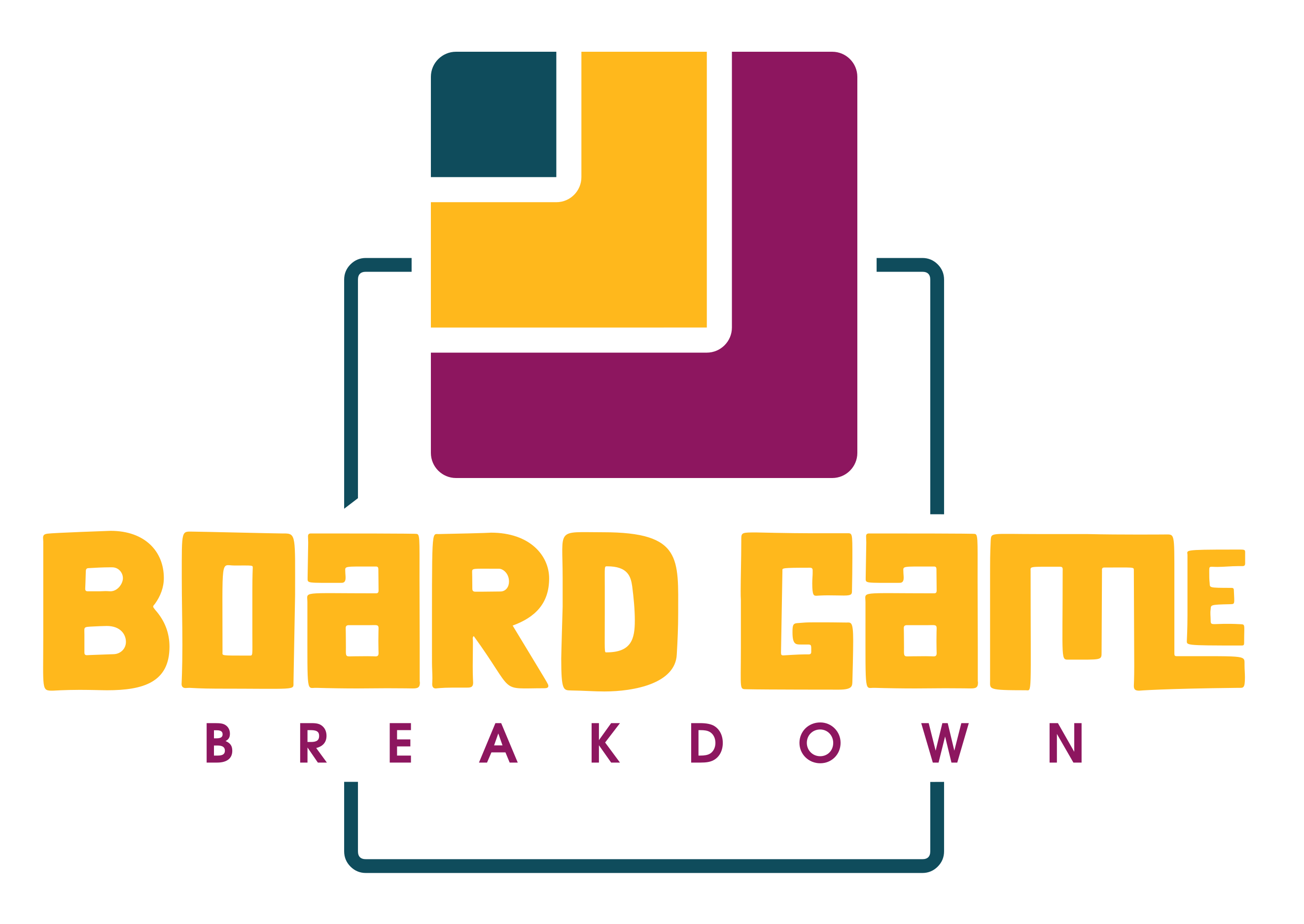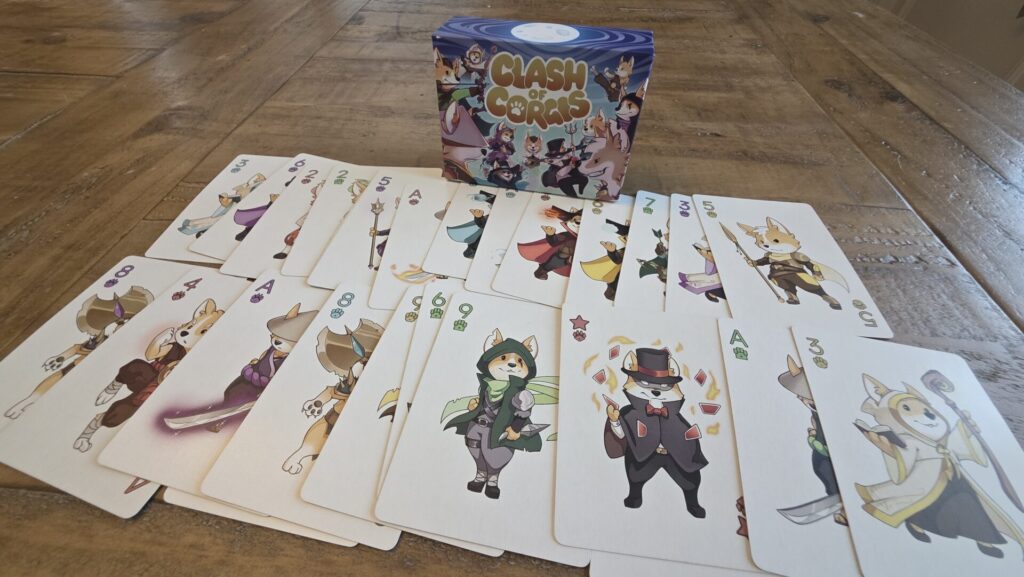
Name: Clash of Corgis
Year of Release: 2023
Player Count: 2 – 4
Playing Time: 5 – 15 Minutes
Designer: Deric Drazich
Publisher: Deric Drazich
Primary Mechanisms: Ladder Climbing, Trick Taking
Weight (According to BGG.com): 1.00
Overview
In the interest of transparency, I received a complimentary copy of Clash of Corgis for review purposes. This did not influence my assessment, and the opinions expressed here are my honest and unbiased reflections on the game.
During middle school, our neighborhood had a large contingent of kids, who miraculously got along well together. This meant that most summer days, we were all hanging out, typically playing basketball or video games with the Worms franchise or the latest EA titles (I can’t believe this statement is even being written) were some of our favorites. Somewhere along the way though, we got really hooked on Uno. It was sort of an obsession, all these kids sitting around a table and playing the card game for hours and just having fun in each other’s company.
I’ve moved on to more complex games in the years since, and while I always have fun playing board games, I think sometimes I take them a little too seriously. Most of the games I enjoy playing just don’t lend themselves to that same feeling that Uno gave us all those years ago… and I’m sure a little thing called nostalgia has to do with it too.
That whole introduction is to say that Clash of Corgis has come pretty close to giving me that feeling again. A quick game that my family and I can play a few hands of, get some laughs at each other’s expense, and pack it up knowing that I won’t be lying in bed later, thinking of all the things I could or couldn’t have done to win. All that said, it does have some minor flaws so continue reading for my full breakdown!
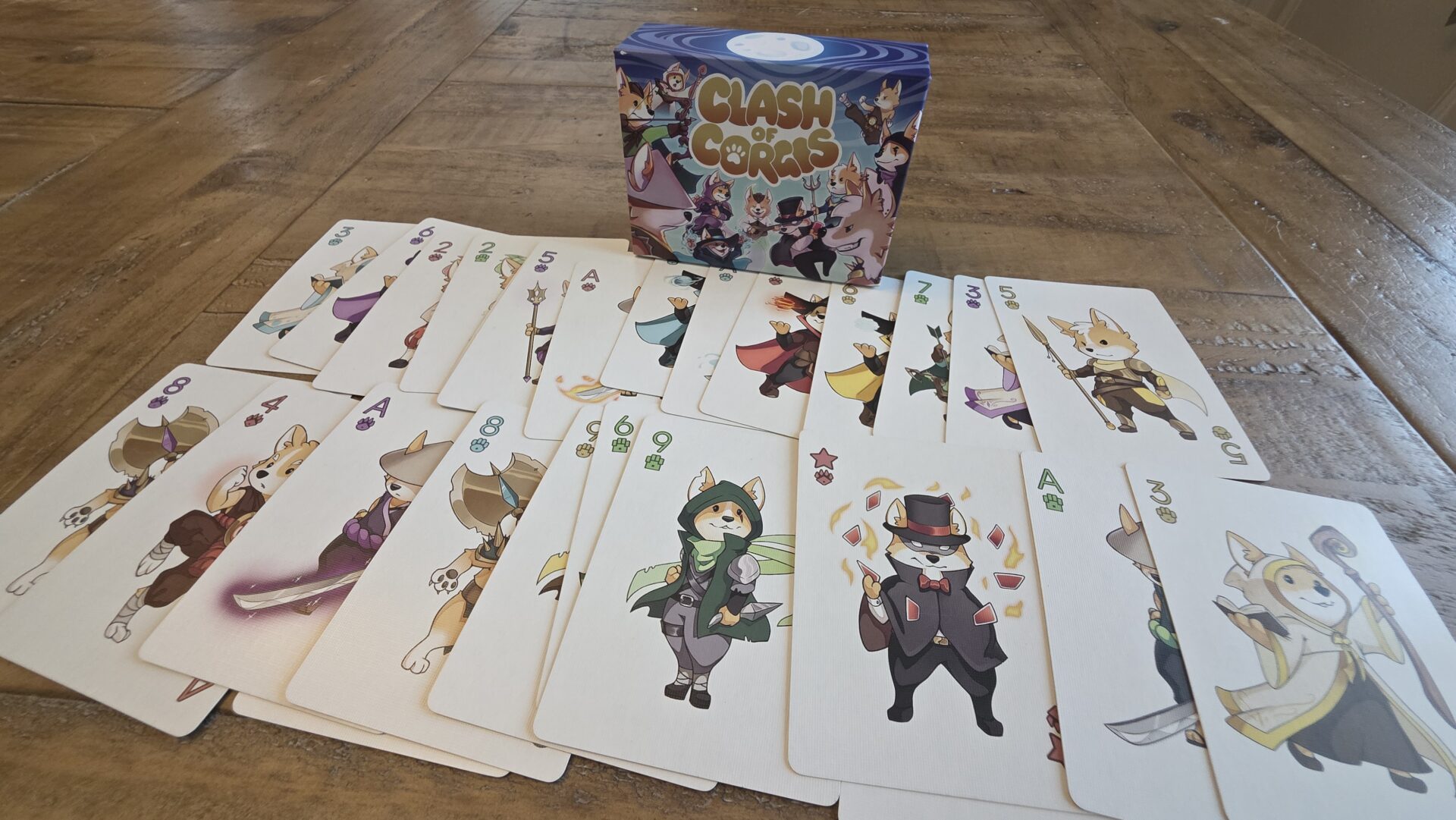
Rulebook & Components
I’m getting older and that’s a fact, even if I don’t want to recognize it. Even in my younger years, my eyesight has never been great but just thinking of the tiny text of the Clash of Corgis rulebook makes my eyes water. This is one of those times I’m going to complain but I don’t really have a great solution for the designer since the game comes in a compact box that is slightly wider than a standard deck of cards. I do appreciate the fact that there is a QR code on the rulebook so that you can check out an online version in case you need to zoom so have your phones ready!
One thing I haven’t touched on yet is that Clash of Corgis can be played in three discrete modes, so the rulebook does have to pack in details for each option. Overall, it does its job but there were two things that I felt weren’t clear enough and were impacting my games. I reached out to the designer to ask my questions, and he promptly responded, which I also appreciated. In future editions, I think that some of the wording could be edited for clarity but overall, it’s a good rulebook that will get you playing the game right away.
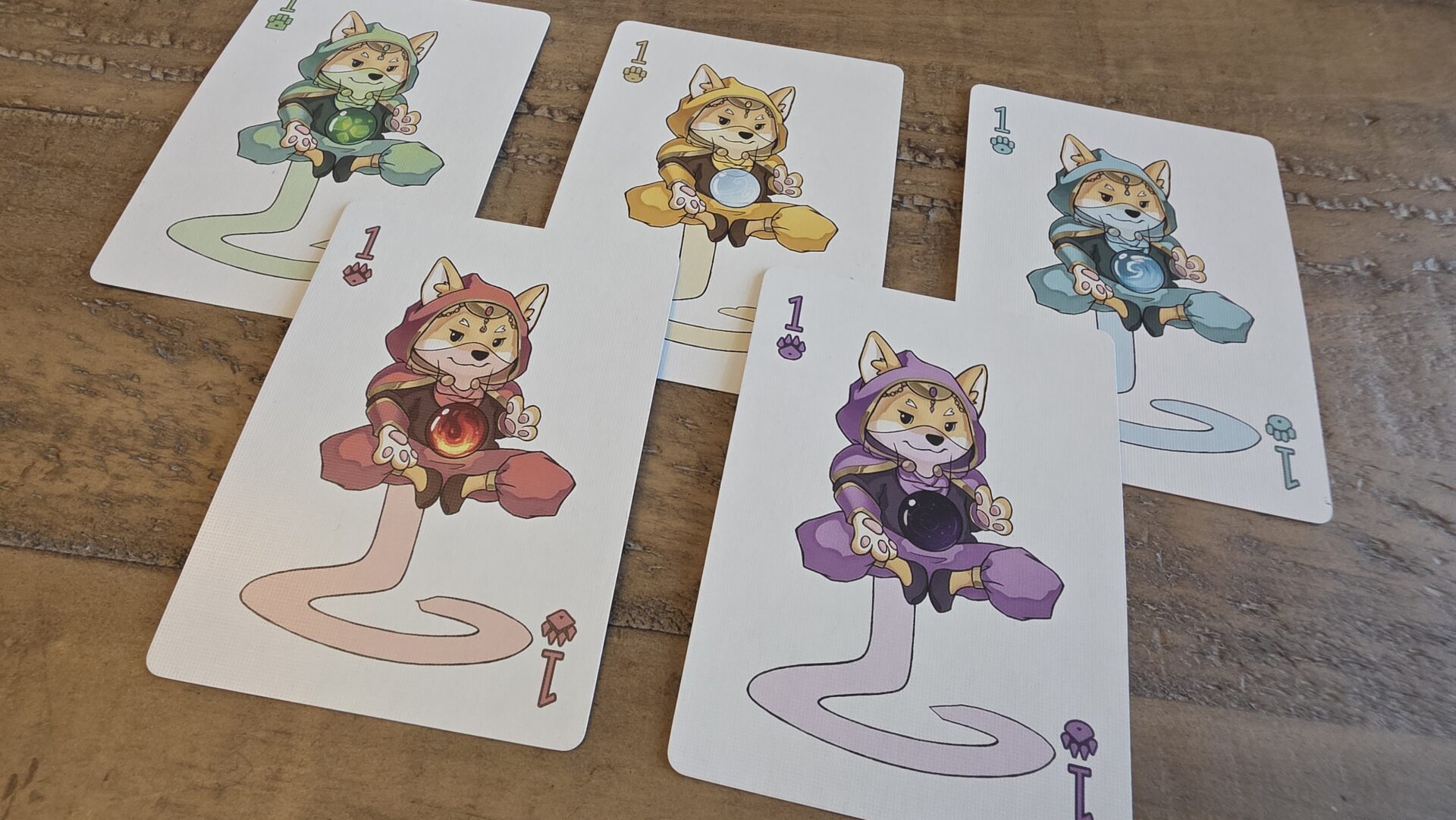
Clash of Corgis is made up of 55 Corgi Cards and four Player Aid Cards. Unlike a lot of games, I do find myself referring to the Player Aid Cards quite a bit, which is helpful. The problem is that there are two different Player Aid Cards (with two sides detailing two of the game modes and the other two sides detailing the third game mode) but the game only comes with two copies of each. This means that if you have any more than two players, someone is having to share a card with someone else. While this doesn’t sound like a huge deal, it kind of breaks up the flow of the game when you’re playing with people who haven’t memorized what every Rank does, and they have to figure out who has the Player Aid Cards to borrow. Maybe in future printings they can print enough copies for all four players to have their own set.
Ok, none of you came here to read about Player Aid Cards, so let’s get down to business and talk about the absolutely wonderfully drawn Corgi Cards. These cards come in five suits, including Earth, Water, Fire, Wind, and Void. The suits themselves have a slightly different paw icon in the corner of each card, but it can be a bit difficult to tell them apart. Thankfully, each suit has its own color so most players will probably utilize this while playing. Within each suit, there are 11 cards, each with a different Rank. These Rank’s have varying names in the rulebook, with the cards themselves being emblazoned with a number between 1 and 9, and then an additional Ace card and a Wild card. Even though the names aren’t on the actual cards, I love thinking of a Berserker Corgi or an Assassin Corgi!
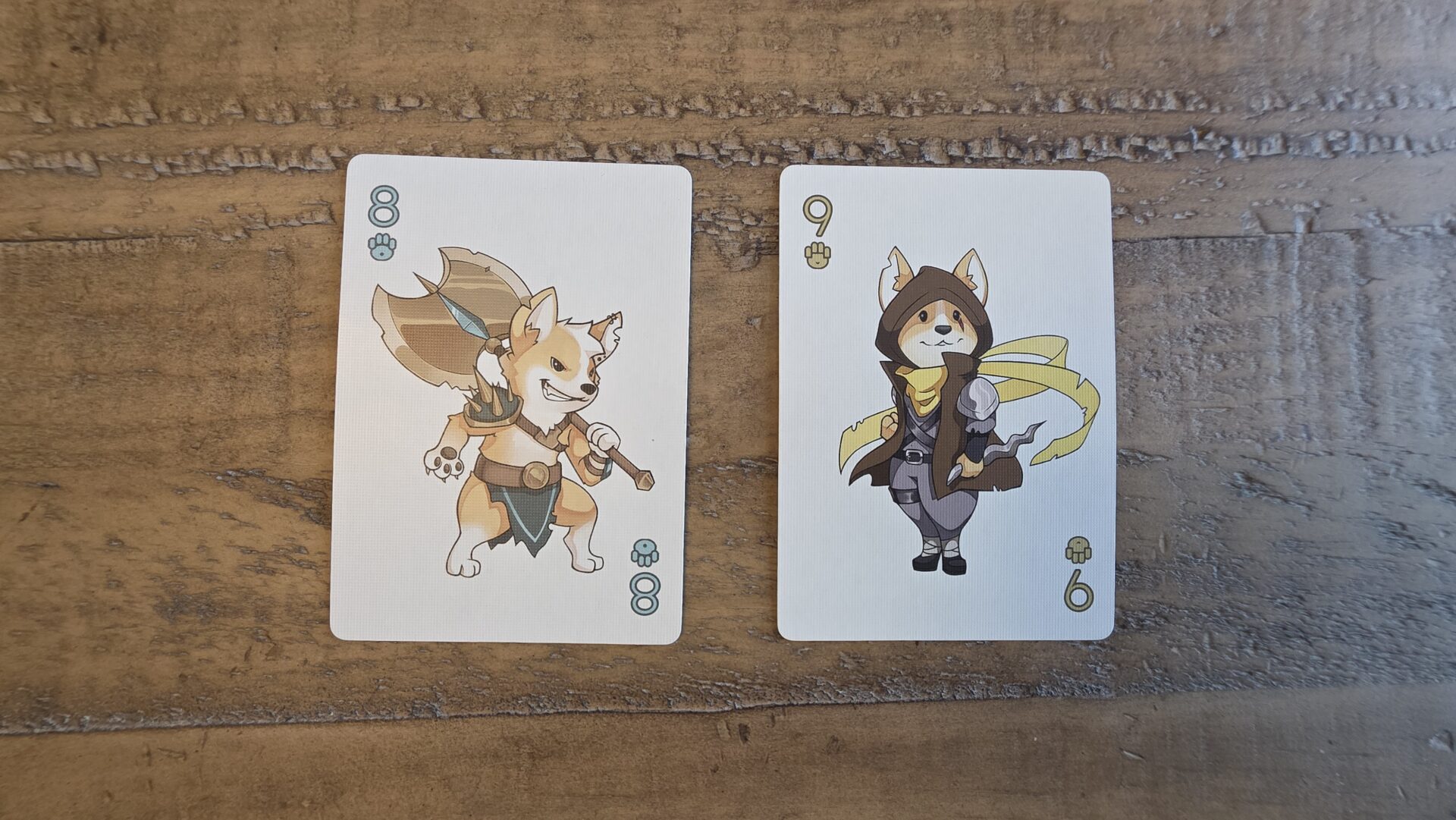
The main draw of the cards has to be the corgis though. The artwork is vibrant, imaginative, and cute while not being so cute that everyone who walks by the table is going to automatically think you’re playing a game for babies (which is what my oldest says every time I play For Northwood!) After our night of playing, my daughter immediately wanted to lay out all the cards and discuss which ones were our favorites, and we had to rank them. I’m partial to the Assassin (who is giving off major Altaïr from Assassin’s Creed vibes) and the Mage. A small detail that I only picked up after we played a handful of games is that some of the pieces of the art are different between the various suits. Take for example, the Fighter card. The yellow Wind Fighter is wielding a rather plain looking spear but grab the blue Water Fighter, and you’ll notice that corgi is equipped with a trident (because you know… water.) For some reason, these little details really tickled me, to the point of me exclaiming loudly to the group what I’d found only for my nine-year-old to say, “it took you that long to notice that?” Ugh, put in my place again!
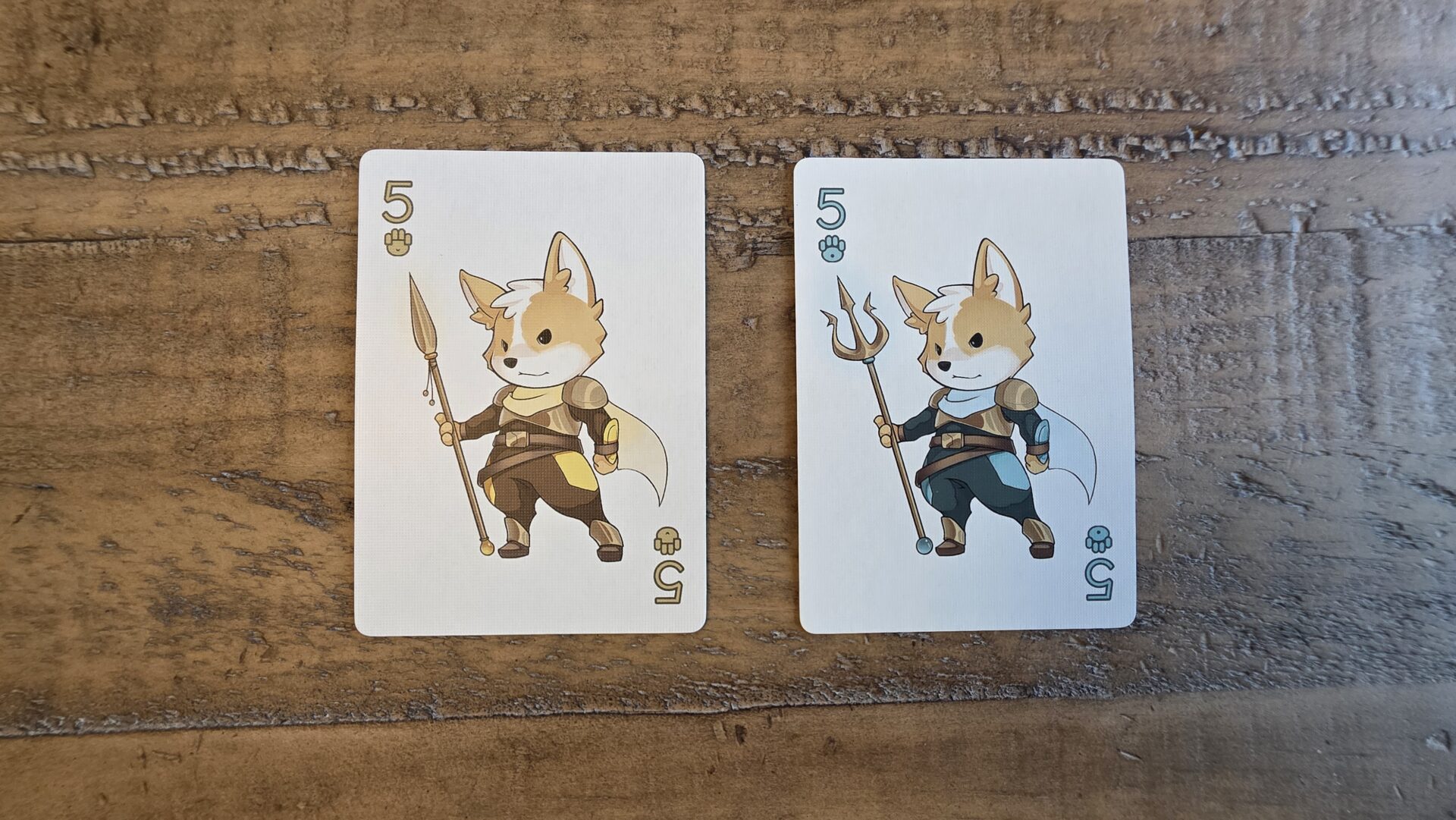
Setup & Gameplay
I mentioned earlier that there are three different ways to play Clash of Corgis. In this section, I’ll give you some details on setup and gameplay for each of the modes of play and then in the General Thoughts section, I’ll tell you what I thought of each.
Original Mode
For setup, deal each player a total of 12 cards and then place the balance of the cards to the side of the table. This mode of the game employs a ladder-climbing mechanism, that I haven’t seen often, at least in the games that I gravitate towards. The starting player will play a card, or cards, to the middle of the table and this becomes the Leading Combo. If the player wants to play more than a single card, then the cards have to be the same Rank, for example, they could play a single 2 – Bard cards, or four 7 – Archer cards. The maximum number of cards that can be put down is five, given that there are only five suits. Before play moves on, the player will look at their trusty Player Aid and perform the action that their played Rank allows them to. I’ll touch on these actions shortly but let’s first see how a round continues.

After the Leading Combo has been established, the next player needs to play a set of cards that has a higher Rank than the Leading Combo. This set of cards has to have the same number of cards as the Leading Combo so if there are four 7 – Archer cards, the next player can’t play two Ace – Samurai cards, as the Leading Combo is made up of a set of four and not two. If the player can’t play, then they must pass to the next person. If a player can put down a set that beats the Leading Combo, then this is the new Leading Combo for the table. Play continues until after playing a Leading Combo, all other players pass in succession. Whoever played the last Leading Combo is declared the winner of this round and they are able to go first the next time, thus being able to discard cards faster than their peers. As soon as someone is out of cards, they are the winner and the game ends.
The actions for each Rank can change between the three game modes. Most of the actions for the Original Mode allow players to shed cards faster or to force their opponents to Expose cards. Exposing means that a player has to take a card from their hand and place it face-up in front of them. While this card is considered to be a part of the player’s card inventory, still having to be discarded in order to win, the player cannot use it in a set for the remainder of the game and must only play it as a single card.
Treasure Island
For this game mode, setup consists of dealing three cards to each player and then putting the deck in the middle of the table. Three phases take place during a player’s turn, with the player choosing to take part in the first and/or second phase, while the third phase is mandatory. The first phase finds the player deciding if they would like to place one of their cards from their hand into a face-up position in front of them, creating a Party. When the card is played, the player then activates the action of that specific Rank.
If the player chooses to take part in the second phase, they must declare out loud to the group, if they wish to fight one, two, or three enemies. After the number is determined, that many cards are drawn from the deck and then flipped over, with the value of each card being added together. If this sum is lower than the sum of the player’s Party, then the player collects the enemy cards, now known as Loot. Consequently, if the enemy cards sum to a value equal or more than the Party’s value, the player loses, and the enemy cards are discarded.
If the player chooses to take part in the second phase, they must declare out loud to the group, if they wish to fight one, two, or three enemies. After the number is determined, that many cards are drawn from the deck and then flipped over, with the value of each card being added together. If this sum is lower than the sum of the player’s Party, then the player collects the enemy cards, now known as Loot. Consequently, if the enemy cards sum to a value equal or more than the Party’s value, the player loses, and the enemy cards are discarded.
In the third phase, the player would start by discarding their Party, if they took part in the second phase. If not, the cards in the Party remain on the table. The player then draws back up to three cards in their hand, and play continues to the next person. The game ends once a player has collected 10 Loot Cards.
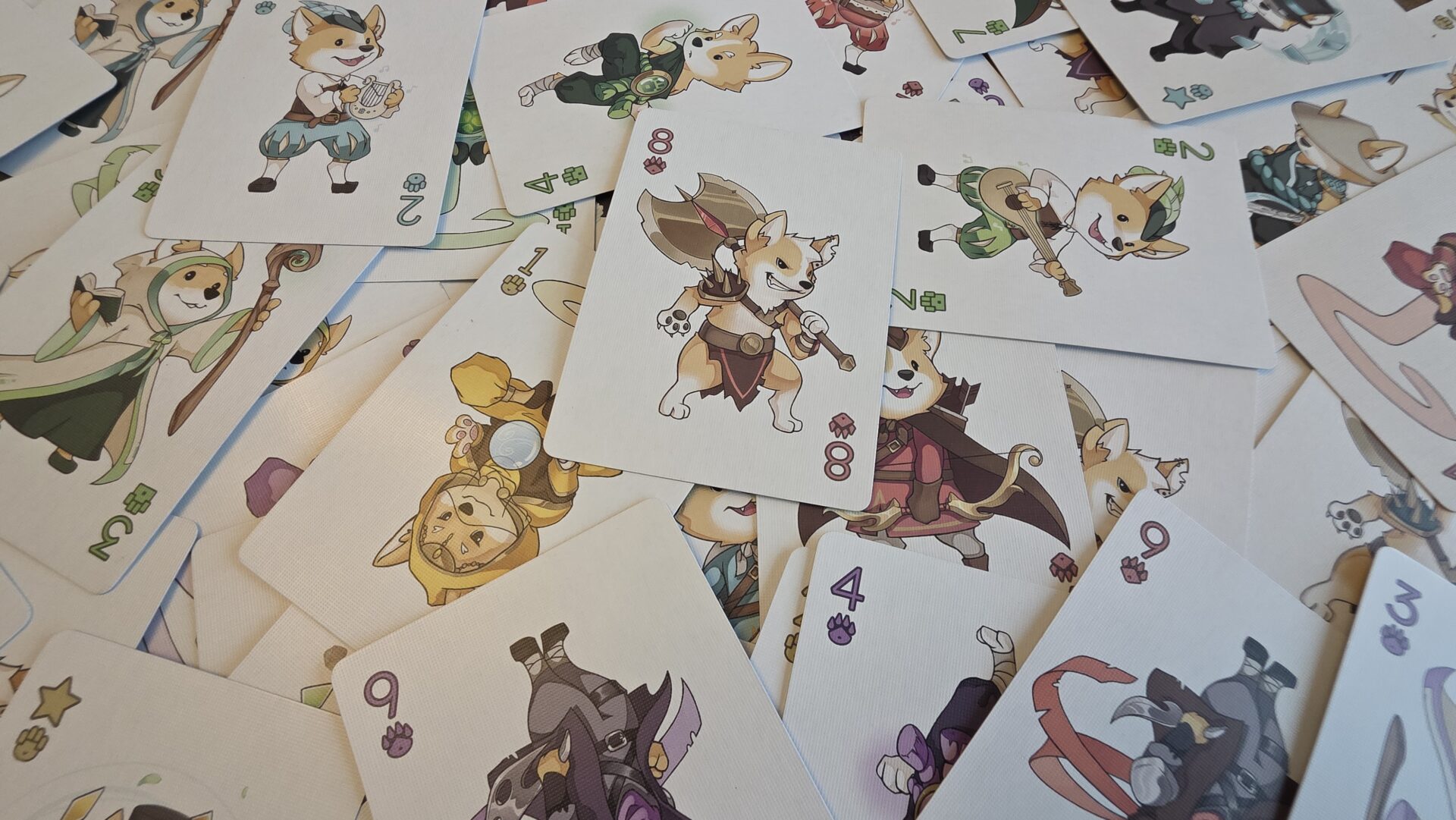
A few things to note is that first, a player can’t have a Party consisting of more than two cards. So, if a player plays a card and then skips the second phase, odds are that when their turn rolls back around, they’ll want to take part in both the first and second phase, as they can’t continue to build up their Party past two cards. Secondly, many of the Corgi Card actions in this game mode let players target opponents and steal a few of their Loot Cards. Lastly, there are additional Bonuses if players are able to put together a party sharing the same Suit or even the same Rank, so watch out for these opportunities to squash the enemies and possibly gain three Loot Cards at once.
The Illusionist
The last game mode in Clash of Corgis is quite a bit different from the other two. Unlike the others that can accommodate up to four players, the third game mode is for two players only. During setup, each player chooses a Suit of cards and takes all 11 of the Corgi Cards. These are then shuffled and then eight of them are placed face-down on the table, in two rows of four cards. The remaining three cards act as the player’s starting hand.
On a player’s turn, they will be Revealing a card from their hand, or from his/her tableau, and performing the stated action. Many of these actions allow the player to sneak a peak at one of the Hidden eight cards in front of them or forces their opponent to have to Reveal cards from their tableau. When a card’s action is enabled, that card is then turned sideways (referred to as Rested), signifying that it can’t be used again this turn. At the end of a player’s turn, they change all Rested Cards back to Revealed (except for any cards that were played that turn).
Play continues back and forth, while players try to deduce where their opponent’s Wild Card is hidden. If a player’s card causes their opponent to unveil their Wild, the opponent has one chance to Save the Illusionist. This is only possible if the player can discard their Ace out of the round, either from their hand or from the table. If so, the Illusionist is placed back into its spot and the game continues. If not, that player has to shuffle their 11 cards and reset their side of the table. If a player’s Illusionist is found twice, the game is over, and they are the loser.
General Thoughts
My favorite aspect of Clash of Corgis is how all three game modes feel different, but they all contain the thread of each Rank having a specific power that can be activated. While each Rank’s power is not exactly the same between the three games, each Rank has a particular feel to it, that I very much appreciate. Playing the Healer in any of the modes gives a wildly different outcome from playing the Berserker, for example.
The negative side of the game modes all feeling different is that some players might only prefer playing one or two of the modes. In my group, I really like the “Blackjack-ness” of Treasure Island mode, but others lean heavily towards the Original mode. This paired with the amount of luck in most modes might impact the mileage this game has for certain groups. But for players who don’t care about luck, or who like some luck in their game, they will find that all modes can be played in under 15 minutes, meaning Clash of Corgis will never overstay its welcome.
If you’re looking for a card game that isn’t bogged down with overly complicated rules and harkens back to the games you could play with a standard 52-deck of cards, look no further than Clash of Corgis. Plus, did I mention it has cute corgis? Who doesn’t want to see corgis on every card in their hand?
Rating
Ratings are based on 5 main criteria: rulebook, setup, components, art & graphic design, and gameplay. The first 4 criteria are rated 1 to 5 and the gameplay is rated 1 to 10. These scores culminate in an “overall satisfaction” score that is rated from 1 to 10. If the reviewed game has both a solo and multiplayer mode, I have assigned scores separately to give context to which mode we enjoy more.
